
The Project Gutenberg EBook of Gift Card Designs, by Pedro J. Lemos This eBook is for the use of anyone anywhere at no cost and with almost no restrictions whatsoever. You may copy it, give it away or re-use it under the terms of the Project Gutenberg License included with this eBook or online at www.gutenberg.org/license Title: Gift Card Designs Author: Pedro J. Lemos Release Date: April 8, 2016 [EBook #51700] Language: English Character set encoding: UTF-8 *** START OF THIS PROJECT GUTENBERG EBOOK GIFT CARD DESIGNS *** Produced by Charlene Taylor, Chuck Greif and the Online Distributed Proofreading Team at http://www.pgdp.net (This file was produced from images generously made available by The Internet Archive)
THERE is less satisfactory holiday hunting for greeting cards than for any other gift. Visit any shop where gift cards are in evidence and you will note how prospective purchasers go over and over the display, finding one here, discarding it later and at the end possibly making a hesitating and unsatisfied selection.
Publishers have stated to me that if there is one symbol of the holiday season that should be rejuvenated, it is the custom of sending gift cards. We can all recall how dear to our eyes were the lace-edged, isinglass, snow-encrusted gift cards, which had to be handled with finger tips, and the singing bird sentiments, which were so daintily revealed by a surprise opening of a flap. These cards, together with the horse-hair sofa and the wax flowers in a glass dome, were part of a certain evolution, and, of course, the only place now for such cards is way down at the bottom of some memory box.
Previous to the world war, America was flooded with cards of a gingerbread tinsel order of decorations turned out by the million in foreign countries. These, as well as postcards, were printed in huge editions by sweat-shop methods, which, together with certain “can’t-be-done-better” slogans, caused our own shops to fall back as competitors.
Now we all know that, no matter how perfect the printing may be, the design and idea must be the selling factor of the gift card. And again, the more the idea and wording meet with the personal or local trend of the community in which it is distributed, the better it will be accepted.
That possibly is the reason why you and I can’t find what we want when we look for a card to express our personal feeling, because it was expressed either in Dresden or London or Hoboken or Squashville. What we need are cards that are typical community expressions from the parts of the country from which they come. It is just as foolish for me to send you a card from California with a home-coming sleigh scene having snow-burdened roofs for a back-ground, as it would be for you to send a decoration unrelated to your environment. Let’s use motifs and scenes and wording which create the charm of our home section, and we will find that the card will be doubly welcomed by the recipient on that account.
If the American card is to be encouraged in America, the designing and appreciation of such must be started right in the art rooms of our schools; and the most important part of such a problem is the lettering.
Lettering need not be approached with fear and trembling, for it can be done with ease and pleasure. I know of students who shunned lettering because they thought it mechanical and laborious, but who, after discovering its possibilities, had almost to be bribed to do anything else.
The old masters and artist-craftsmen recognized that lettering could be as artistic as the worker desired and nothing is more beautiful in lettering than the illuminated manuscripts and books of those ages.
The easiest way to produce lettering is to use the lettering pens. These pens are made with a separate, small brass tip which is placed on the pen as a fountain. The fountain is filled from the quill of the drawing ink bottle, just as the ink is put into a ruling pen. As the pens come in about twelve different stroke-widths, it is well to have a pen holder for each size. This will save confusion and time. When the pen is being used it should be held so that both sides of the pen-point rest on the paper. It is not necessary to press the pen for wide parts, as it will almost automatically produce the wide strokes when brought downward and the thin strokes when brought upward.
The board on which the drawing is made should be placed at an angle of 45 degrees to permit the ink to flow well. If too great a slant is used, the ink, strange to say, refuses to run up hill, and if the board is placed flat, the ink on the pen will be too ambitious to arrive.
Before beginning a card, the idea should be roughly planned, so that the general forms may be considered. This is termed the “dummy.” In planning the dummy, consider carefully the margins. Good lettering is often spoiled by poor spacing. Because you are doing lettering, do not ignore design principles. Every design principle you know of can be used in lettering, just as it can be in any art application.
To prevent your lettering from being at a slant, or “off its feet,” to use the printer’s term, you should rule light vertical plumb lines to guide your letter strokes.
When lettering, remember that unity must be thought of continually. If the finish of each stroke or “serif” is large on the first letter, it must be similar on all other letters. The thin strokes throughout a line of lettering should be equal in weight. This rule applies also to the thick strokes. The lettering pens take care of this if used properly and if no undue pressure is placed on the pen.
A beautiful initial is always a happy beginning to a quotation. With color or illumination added, much charm is possible. If the lettering is on soft-surfaced paper, it will be found that a leather tool or other metal point can be used for tooling the initial from the back as well as from the front. Gold or silver water colors, added with proper restraint give a sparkle to the card.
If your class wishes to raise funds for some worthy enterprise try having a class competition for gift cards. The verses can be a problem for the class in English. Selecting the best half-dozen designs, get in touch with an engraver, and have the students make working-drawings. Right there you will learn something new about drawing for the industries. Then after the engravings are received, if your school is one of the fortunate ones with a printing department, have your students co-operate with the printing students in securing the right colors, etc. Plan envelopes, which can be easily made by cutting the paper from patterns and then folding and pasting them together.
Beginners in gift card designing should all be encouraged to start with simple work, similar to that in Plate 3. Such work results in well-designed cards and is encouraging to the originator. The idea of using cut paper is always good with amateur artists, as it helps them to keep their work simple and makes color harmonies easier. Elaborate ideas, such as figures, ornate designs, etc., should be avoided at the start.
In selecting colors, the students should be encouraged to use subdued or grayed tones, for, by this means, they are much more certain of obtaining a rich-looking card. There are too many printed cards already on the market which are done in gaudy colors, without adding more. If cut paper cards are made, the students can decide on the colors they want by laying strips of the colored paper side by side, until the best color scheme has been decided upon.
Too much stress cannot be laid upon good placing or arrangement of the lettering. In Plate 4, we have a series of cards that are fairly good, but that would have been quite a bit improved by better lettering. The ideas and general arrangement of these cards make them good suggestions.
Often we find students in classes turning out cards all based upon the same general composition. It is easy for students to follow a general type of card suggested by the teacher or some progressive young artist. In Plate 5, we find a page of ten typical arrangements. Although different as to basic composition, they are all good, and can be used as a start for original work. Always bear in mind the idea that both lettering and decoration should be in complete harmony. Light fantastic lettering, for instance, would not be in harmony with heavy, bold decorations.
In late years we find many artists and designers, who cannot find suitable cards in the book shops, sketching designs of their own and having them printed. In this way they can put in an individual touch and produce a card that exactly meets their requirements. Although such a card is more expensive than a stock card, the plan works out well for those who have a fair list of mailing acquaintances. A page of such cards is shown in Plate 6.
The use of flat, massive tones, provided the colors are not too heavy, always makes a distinctive card. Plate 7 shows a page of such designs. A good typical example is the card in the lower right hand corner which contains the quotation from Dickens. The use of toned paper often helps. At most art stores it is possible to obtain a vegetable parchment paper which makes splendid material on which to draw or print the strong, decorative type of gift card.
Oftentimes we receive or send holiday cards that are based on a humorous trend. Nothing takes so well as a bit of verse with a smile tied onto it somewhere, provided it is well done. A cheerful card is generally kept and placed where its owner can see it often. Designs for such cards should be well-planned, in order to avoid an appearance of the comic valentine in their general make-up. A page of work having the semi-humorous element is found in Plate 8.
Anyone desiring to reproduce an artistic card with the minimum expense, will do well to look into the idea of using cut linoleum. By planning motifs that hold well together, and are strong in design, it is possible to cut out some very acceptable blocks in heavy linoleum. From these, almost any number of gift cards can be printed by hand in varied colors. When dry, these cards can be hand colored. Because of the difficulty in cutting out the letters, one should use as few words as possible. Designs adapted to this work are found in Plate 9.
Occasionally, students having a natural bent or enthusiasm for design will be found anxious to produce a card of the style found in Plate 10. In cards of this kind, careful attention must be given to the motifs used and to the placing of these motifs in the general composition. As most of the stress is laid on the design, rather than the lettering, it is important that this design be well planned and equally well carried out. In case of doubt, it is better to leave out some of the ornament rather than have the card overcrowded or ornate.
The holiday motifs shown in Plate 11 are not only adapted to gift cards, but also to posters, place cards, and room or tree decorations. It is a good problem to allow the students to take such a page of motifs and from them to plan their own card, using their own ideas as to size of card, proportion, lettering, etc. This is splendid training for the artists in the line of what is known to the printers as “make-up.” After the preliminary sketches have been made the teacher can call attention to mistakes in balance, rhythm, etc., and suggest corrections.
Other useful ornaments, not only for Christmas but also for Easter and Hallowe’en, are found in Plates 12 and 13. The test of a student’s ability lies in the way he is able to arrange such motifs into a good card, or the manner in which he derives ideas from these motifs for original work.
Plate 14 gives us some very effective motifs for Washington’s Birthday. These figures can be cut in paper, done in opaque wash, or finished in pen and ink. Original poems may be written by members of the class and added to the card. School programs or invitations can be made a class problem for this topic.
Valentines also afford a good opportunity for a class problem. Try to encourage in the students the development of new ideas or original treatment in the handling of their valentine cards. A card does not need to be gaudy, over-elaborate, or grotesque, in order to be attractive. A few simple motifs, well placed, and with good coloring, will produce the most pleasing kind of a card. Humorous cards, containing good clean fun are always acceptable, if well done.
A Valentine containing unique possibilities is shown in Plate 16. The same idea can be varied so as to make a number of novel cards. The little envelope, which this card features, is easily constructed and will hold quite a message, if written carefully. The figure of the messenger can be hand colored in buff and vermilion.
The cards and motifs shown on these plates make a series of general suggestions. Based on the types shown here, as regards lettering, design, and card sizes, gift cards for the various holidays and for birthdays can be planned and worked out. Once your students produce such cards, they will never again be satisfied with stock cards. Successful students can find remuneration as well as much joy in designing gift cards for their friends’ needs, and in time may be able to create a market in their own locality.
Problem 1. Have students select or originate a good Christmas sentiment. Next, sketch on an 8 x 10 sheet of pencil paper four different arrangements of this idea.
Problem 2. After selecting the best composition from sketches in Problem 1, plan a card and envelope arrangement to go with it. Study over suggestions given in Plate 2.
Problem 3. Using three colors and a tinted paper, complete the idea planned in Problems 1 and 2. Possibly two varied types of cards can be worked up.
Problem 4. As a variation, design and complete two simple cards in cut paper. Use about four colors, using the background as one of the colors.
Problem 5. Keeping the flat decorative type of work as a standard study the cards in Plate 7. Next, design a Christmas folder of two or four pages, having a cover design and lettered verse inside.
Problem 6. Plan a set of four holiday tags or stickers to go with packages. These should not exceed 2 x 3 inches in size and can be of the semi-humorous type.
Problem 7. Have students copy a good pen alphabet using both the capitals and small letters. This card should be made on a 8 x 10 sheet of bristol board.
Problem 8. Either look up or originate some text that will make a good holiday gift. Block out a wall card that will be about 6 x 9 inches in proportion and design the motto to fit this space using the pen letters studied.
Problem 9. Study the cut paper cards made in Problem 4. Also look at Plate 9. Next, on pencil paper, block out two compositions that will cut well in linoleum. Select the best and work it out carefully in color, planning every part in flat tones.
Problem 10. From color sketch, trace and cut out the linoleum blocks. Using opaque water colors, print a set of fifteen or twenty good cards. Make envelopes to go with them. Vary color schemes if desired.
Problem 11. Allow each student to originate a color scheme and table plan for a Christmas dinner. After this has been perfected, have each student make six place cards to go with the decorations.
Problem 12. Study suggestions in Plate 12 and 13. From these or other material, design one round and one oblong sticker to be placed on a gift package. This may be for any of the holidays or for a birthday.
Problem 13. Look over Plate 14. Using these suggestions or similar ones, plan a program or an invitation to Washington’s Birthday exercises at the school. Size and color optional.
Problem 14. Study Plates 15 and 16. Next, design two good Valentines, one being of the greeting type and the other having some novelty added, as the one found in Plate 16. Keep lettering clear and simple.
Problem 15. Design an artistic Easter Card, using white or cream paper and delicate coloring. Tie with appropriate cord or ribbon.
Problem 16. Plan invitations to a Fourth of July party. Work for a unique effect without using too many colors.
Problem 17. Do the same with Hallowe’en, using cut paper instead of colors.
Problem 18. Design an invitation to a Thanksgiving dinner, using a combination of ink outlines and flat washes of watercolor.
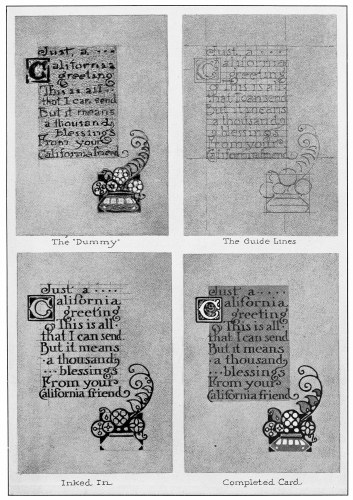
A Good Gift Card is always first sketched in lightly and planned from the standpoint of good balance and design. In designing a card always try several small arrangements or compositions before deciding on the one to complete.
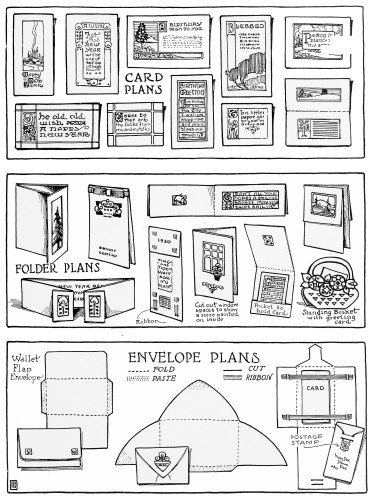
In Addition to the planning of the lettering, the designer has an opportunity for invention as regards the type of card and its envelope or container. A novel idea goes a long way toward success.
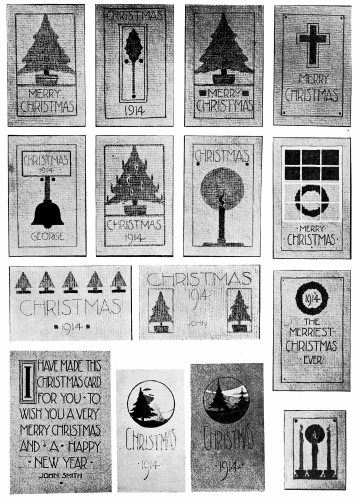
Nothing pleases the receiver so much as a hand finished card from some good friend. Above are some simple designs that any artist could produce. These originals were made by children.
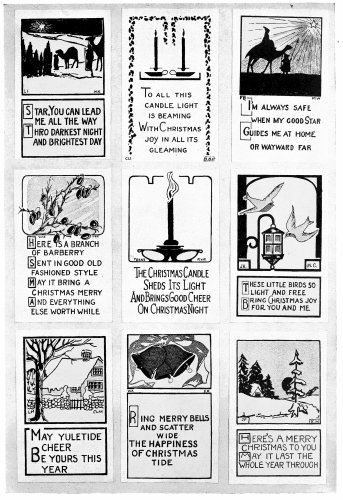
Another Page containing some simple compositions. By using subdued tones of green, red and white on a gray or buff paper, very interesting color effects may be obtained. These were made by students in high school grades.
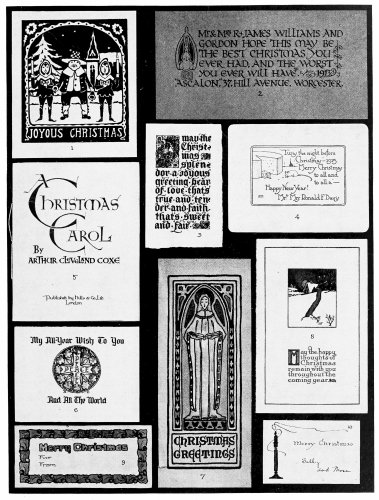
Christmas Cards. Ten typical arrangements. 1. Full panel decorations. 2. Initial decoration. 3. Ornamental initial. 4. Text illustrated. 5. Lettering only. 6. Lettering and panel ornament. 7. Panel decoration and text panel. 8. Pictorial panel and text. 9. Border decoration. 10. Free symbol and text. All the originals, several published for general sale, others privately printed, were in color. 3, 6, 7, 9, and 10 were hand colored. To make an original card, choose the arrangement that seems most desirable, and substitute elements having a personal appeal—other salutations or quotations and appropriate decorative elements.
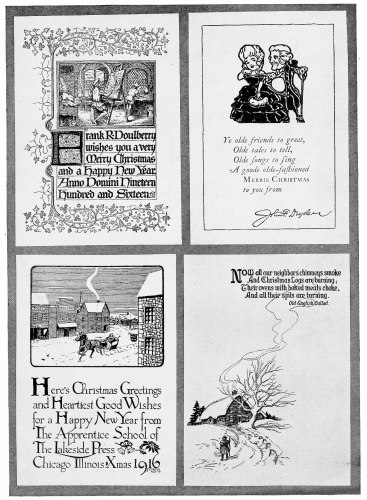
Four Varied Styles of design in holiday cards, for more advanced talent. Note how each one is based on a foundation of good design. These cards were all designed by those sending them out as personal greetings.
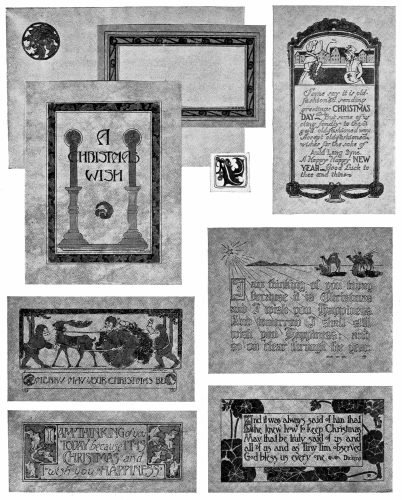
A Page of strong designs made by art school students. Notice how the designs have been kept in simple broad masses and the lettering made part of the design. The originals in color were even more unified.

A Page of Christmas Cards in which a semi-humorous element has been incorporated. Cards like these often create a pleasant variation from the more formal ones. These were designed by high school students.

Strong, Well Massed Designs like these are well adapted to work in cut linoleum. If printed in a deep gray or brown and hand colored with light washes of transparent color they make an unusually rich looking card.
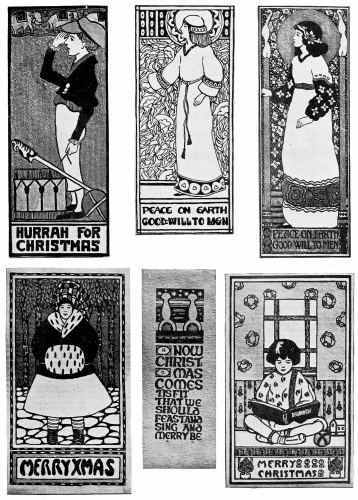
Cards using figures of the poster type. In these the accent has been placed on the decorative design quality. If properly done, such a problem gives the student fine training in spacing, balance and rhythm, and results in a highly artistic card.
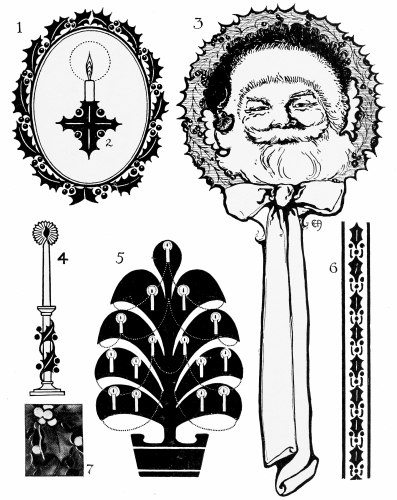
A Set of holiday motifs that will help in planning Christmas Gift Cards or quotations. These are simple enough to be used by beginners.
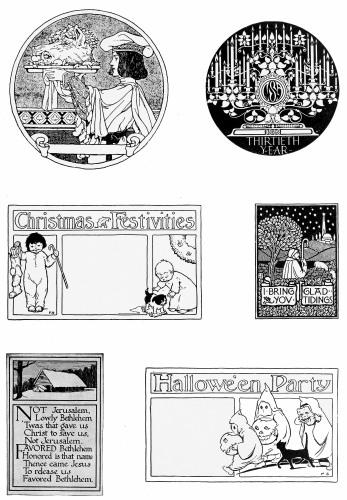
A Page of useful holiday designs. These may be used as the basis of original cards. Their wide range suggests a variation of techniques. Simple line drawings, similar to that of Hallowe’en are best adapted to hand coloring.
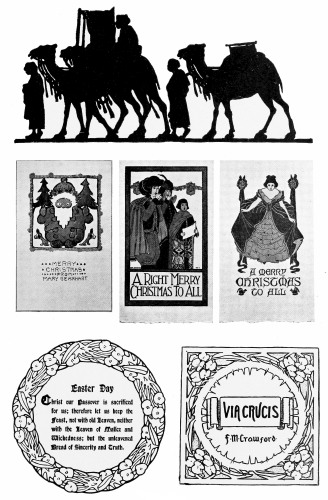
Another Page of good suggestions. The silhouette at the top suggests possibilities in cut paper for the little folks. The use of cut out motifs in colored paper is an easy way for the younger artists to make their cards.
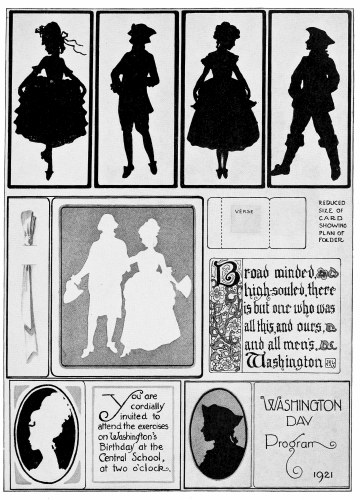
Suggestions for Washington’s Birthday. Silhouettes may be produced in cut paper, stencil work, opaque colors or pen and ink. Both Washington’s and Lincoln’s Birthday offer good opportunities for art projects.
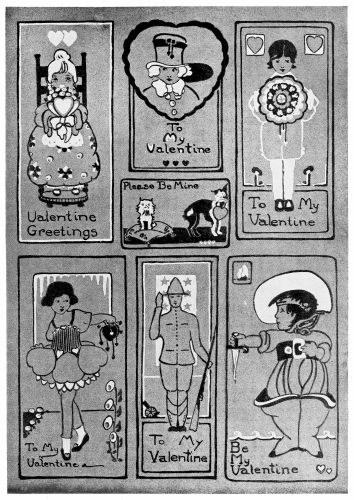
A Page of interesting Valentine designs. The use of a light and dark color against a medium toned paper is a sure way of obtaining quick and effective results. Variations, without figures, can be made by the younger artists.
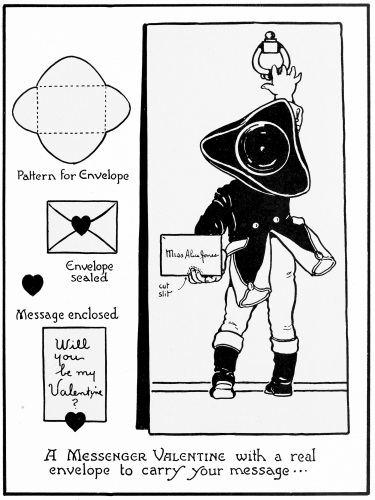
A Unique Valentine Design. In this one an individual message can be written and put in the little envelope. Variations, such as a little dog holding a valentine-letter or a bird with one in his bill might be worked out similar to this idea.
End of the Project Gutenberg EBook of Gift Card Designs, by Pedro J. Lemos
*** END OF THIS PROJECT GUTENBERG EBOOK GIFT CARD DESIGNS ***
***** This file should be named 51700-h.htm or 51700-h.zip *****
This and all associated files of various formats will be found in:
http://www.gutenberg.org/5/1/7/0/51700/
Produced by Charlene Taylor, Chuck Greif and the Online
Distributed Proofreading Team at http://www.pgdp.net (This
file was produced from images generously made available
by The Internet Archive)
Updated editions will replace the previous one--the old editions
will be renamed.
Creating the works from public domain print editions means that no
one owns a United States copyright in these works, so the Foundation
(and you!) can copy and distribute it in the United States without
permission and without paying copyright royalties. Special rules,
set forth in the General Terms of Use part of this license, apply to
copying and distributing Project Gutenberg-tm electronic works to
protect the PROJECT GUTENBERG-tm concept and trademark. Project
Gutenberg is a registered trademark, and may not be used if you
charge for the eBooks, unless you receive specific permission. If you
do not charge anything for copies of this eBook, complying with the
rules is very easy. You may use this eBook for nearly any purpose
such as creation of derivative works, reports, performances and
research. They may be modified and printed and given away--you may do
practically ANYTHING with public domain eBooks. Redistribution is
subject to the trademark license, especially commercial
redistribution.
*** START: FULL LICENSE ***
THE FULL PROJECT GUTENBERG LICENSE
PLEASE READ THIS BEFORE YOU DISTRIBUTE OR USE THIS WORK
To protect the Project Gutenberg-tm mission of promoting the free
distribution of electronic works, by using or distributing this work
(or any other work associated in any way with the phrase "Project
Gutenberg"), you agree to comply with all the terms of the Full Project
Gutenberg-tm License (available with this file or online at
http://gutenberg.org/license).
Section 1. General Terms of Use and Redistributing Project Gutenberg-tm
electronic works
1.A. By reading or using any part of this Project Gutenberg-tm
electronic work, you indicate that you have read, understand, agree to
and accept all the terms of this license and intellectual property
(trademark/copyright) agreement. If you do not agree to abide by all
the terms of this agreement, you must cease using and return or destroy
all copies of Project Gutenberg-tm electronic works in your possession.
If you paid a fee for obtaining a copy of or access to a Project
Gutenberg-tm electronic work and you do not agree to be bound by the
terms of this agreement, you may obtain a refund from the person or
entity to whom you paid the fee as set forth in paragraph 1.E.8.
1.B. "Project Gutenberg" is a registered trademark. It may only be
used on or associated in any way with an electronic work by people who
agree to be bound by the terms of this agreement. There are a few
things that you can do with most Project Gutenberg-tm electronic works
even without complying with the full terms of this agreement. See
paragraph 1.C below. There are a lot of things you can do with Project
Gutenberg-tm electronic works if you follow the terms of this agreement
and help preserve free future access to Project Gutenberg-tm electronic
works. See paragraph 1.E below.
1.C. The Project Gutenberg Literary Archive Foundation ("the Foundation"
or PGLAF), owns a compilation copyright in the collection of Project
Gutenberg-tm electronic works. Nearly all the individual works in the
collection are in the public domain in the United States. If an
individual work is in the public domain in the United States and you are
located in the United States, we do not claim a right to prevent you from
copying, distributing, performing, displaying or creating derivative
works based on the work as long as all references to Project Gutenberg
are removed. Of course, we hope that you will support the Project
Gutenberg-tm mission of promoting free access to electronic works by
freely sharing Project Gutenberg-tm works in compliance with the terms of
this agreement for keeping the Project Gutenberg-tm name associated with
the work. You can easily comply with the terms of this agreement by
keeping this work in the same format with its attached full Project
Gutenberg-tm License when you share it without charge with others.
1.D. The copyright laws of the place where you are located also govern
what you can do with this work. Copyright laws in most countries are in
a constant state of change. If you are outside the United States, check
the laws of your country in addition to the terms of this agreement
before downloading, copying, displaying, performing, distributing or
creating derivative works based on this work or any other Project
Gutenberg-tm work. The Foundation makes no representations concerning
the copyright status of any work in any country outside the United
States.
1.E. Unless you have removed all references to Project Gutenberg:
1.E.1. The following sentence, with active links to, or other immediate
access to, the full Project Gutenberg-tm License must appear prominently
whenever any copy of a Project Gutenberg-tm work (any work on which the
phrase "Project Gutenberg" appears, or with which the phrase "Project
Gutenberg" is associated) is accessed, displayed, performed, viewed,
copied or distributed:
This eBook is for the use of anyone anywhere at no cost and with
almost no restrictions whatsoever. You may copy it, give it away or
re-use it under the terms of the Project Gutenberg License included
with this eBook or online at www.gutenberg.org/license
1.E.2. If an individual Project Gutenberg-tm electronic work is derived
from the public domain (does not contain a notice indicating that it is
posted with permission of the copyright holder), the work can be copied
and distributed to anyone in the United States without paying any fees
or charges. If you are redistributing or providing access to a work
with the phrase "Project Gutenberg" associated with or appearing on the
work, you must comply either with the requirements of paragraphs 1.E.1
through 1.E.7 or obtain permission for the use of the work and the
Project Gutenberg-tm trademark as set forth in paragraphs 1.E.8 or
1.E.9.
1.E.3. If an individual Project Gutenberg-tm electronic work is posted
with the permission of the copyright holder, your use and distribution
must comply with both paragraphs 1.E.1 through 1.E.7 and any additional
terms imposed by the copyright holder. Additional terms will be linked
to the Project Gutenberg-tm License for all works posted with the
permission of the copyright holder found at the beginning of this work.
1.E.4. Do not unlink or detach or remove the full Project Gutenberg-tm
License terms from this work, or any files containing a part of this
work or any other work associated with Project Gutenberg-tm.
1.E.5. Do not copy, display, perform, distribute or redistribute this
electronic work, or any part of this electronic work, without
prominently displaying the sentence set forth in paragraph 1.E.1 with
active links or immediate access to the full terms of the Project
Gutenberg-tm License.
1.E.6. You may convert to and distribute this work in any binary,
compressed, marked up, nonproprietary or proprietary form, including any
word processing or hypertext form. However, if you provide access to or
distribute copies of a Project Gutenberg-tm work in a format other than
"Plain Vanilla ASCII" or other format used in the official version
posted on the official Project Gutenberg-tm web site (www.gutenberg.org),
you must, at no additional cost, fee or expense to the user, provide a
copy, a means of exporting a copy, or a means of obtaining a copy upon
request, of the work in its original "Plain Vanilla ASCII" or other
form. Any alternate format must include the full Project Gutenberg-tm
License as specified in paragraph 1.E.1.
1.E.7. Do not charge a fee for access to, viewing, displaying,
performing, copying or distributing any Project Gutenberg-tm works
unless you comply with paragraph 1.E.8 or 1.E.9.
1.E.8. You may charge a reasonable fee for copies of or providing
access to or distributing Project Gutenberg-tm electronic works provided
that
- You pay a royalty fee of 20% of the gross profits you derive from
the use of Project Gutenberg-tm works calculated using the method
you already use to calculate your applicable taxes. The fee is
owed to the owner of the Project Gutenberg-tm trademark, but he
has agreed to donate royalties under this paragraph to the
Project Gutenberg Literary Archive Foundation. Royalty payments
must be paid within 60 days following each date on which you
prepare (or are legally required to prepare) your periodic tax
returns. Royalty payments should be clearly marked as such and
sent to the Project Gutenberg Literary Archive Foundation at the
address specified in Section 4, "Information about donations to
the Project Gutenberg Literary Archive Foundation."
- You provide a full refund of any money paid by a user who notifies
you in writing (or by e-mail) within 30 days of receipt that s/he
does not agree to the terms of the full Project Gutenberg-tm
License. You must require such a user to return or
destroy all copies of the works possessed in a physical medium
and discontinue all use of and all access to other copies of
Project Gutenberg-tm works.
- You provide, in accordance with paragraph 1.F.3, a full refund of any
money paid for a work or a replacement copy, if a defect in the
electronic work is discovered and reported to you within 90 days
of receipt of the work.
- You comply with all other terms of this agreement for free
distribution of Project Gutenberg-tm works.
1.E.9. If you wish to charge a fee or distribute a Project Gutenberg-tm
electronic work or group of works on different terms than are set
forth in this agreement, you must obtain permission in writing from
both the Project Gutenberg Literary Archive Foundation and Michael
Hart, the owner of the Project Gutenberg-tm trademark. Contact the
Foundation as set forth in Section 3 below.
1.F.
1.F.1. Project Gutenberg volunteers and employees expend considerable
effort to identify, do copyright research on, transcribe and proofread
public domain works in creating the Project Gutenberg-tm
collection. Despite these efforts, Project Gutenberg-tm electronic
works, and the medium on which they may be stored, may contain
"Defects," such as, but not limited to, incomplete, inaccurate or
corrupt data, transcription errors, a copyright or other intellectual
property infringement, a defective or damaged disk or other medium, a
computer virus, or computer codes that damage or cannot be read by
your equipment.
1.F.2. LIMITED WARRANTY, DISCLAIMER OF DAMAGES - Except for the "Right
of Replacement or Refund" described in paragraph 1.F.3, the Project
Gutenberg Literary Archive Foundation, the owner of the Project
Gutenberg-tm trademark, and any other party distributing a Project
Gutenberg-tm electronic work under this agreement, disclaim all
liability to you for damages, costs and expenses, including legal
fees. YOU AGREE THAT YOU HAVE NO REMEDIES FOR NEGLIGENCE, STRICT
LIABILITY, BREACH OF WARRANTY OR BREACH OF CONTRACT EXCEPT THOSE
PROVIDED IN PARAGRAPH 1.F.3. YOU AGREE THAT THE FOUNDATION, THE
TRADEMARK OWNER, AND ANY DISTRIBUTOR UNDER THIS AGREEMENT WILL NOT BE
LIABLE TO YOU FOR ACTUAL, DIRECT, INDIRECT, CONSEQUENTIAL, PUNITIVE OR
INCIDENTAL DAMAGES EVEN IF YOU GIVE NOTICE OF THE POSSIBILITY OF SUCH
DAMAGE.
1.F.3. LIMITED RIGHT OF REPLACEMENT OR REFUND - If you discover a
defect in this electronic work within 90 days of receiving it, you can
receive a refund of the money (if any) you paid for it by sending a
written explanation to the person you received the work from. If you
received the work on a physical medium, you must return the medium with
your written explanation. The person or entity that provided you with
the defective work may elect to provide a replacement copy in lieu of a
refund. If you received the work electronically, the person or entity
providing it to you may choose to give you a second opportunity to
receive the work electronically in lieu of a refund. If the second copy
is also defective, you may demand a refund in writing without further
opportunities to fix the problem.
1.F.4. Except for the limited right of replacement or refund set forth
in paragraph 1.F.3, this work is provided to you 'AS-IS' WITH NO OTHER
WARRANTIES OF ANY KIND, EXPRESS OR IMPLIED, INCLUDING BUT NOT LIMITED TO
WARRANTIES OF MERCHANTABILITY OR FITNESS FOR ANY PURPOSE.
1.F.5. Some states do not allow disclaimers of certain implied
warranties or the exclusion or limitation of certain types of damages.
If any disclaimer or limitation set forth in this agreement violates the
law of the state applicable to this agreement, the agreement shall be
interpreted to make the maximum disclaimer or limitation permitted by
the applicable state law. The invalidity or unenforceability of any
provision of this agreement shall not void the remaining provisions.
1.F.6. INDEMNITY - You agree to indemnify and hold the Foundation, the
trademark owner, any agent or employee of the Foundation, anyone
providing copies of Project Gutenberg-tm electronic works in accordance
with this agreement, and any volunteers associated with the production,
promotion and distribution of Project Gutenberg-tm electronic works,
harmless from all liability, costs and expenses, including legal fees,
that arise directly or indirectly from any of the following which you do
or cause to occur: (a) distribution of this or any Project Gutenberg-tm
work, (b) alteration, modification, or additions or deletions to any
Project Gutenberg-tm work, and (c) any Defect you cause.
Section 2. Information about the Mission of Project Gutenberg-tm
Project Gutenberg-tm is synonymous with the free distribution of
electronic works in formats readable by the widest variety of computers
including obsolete, old, middle-aged and new computers. It exists
because of the efforts of hundreds of volunteers and donations from
people in all walks of life.
Volunteers and financial support to provide volunteers with the
assistance they need, are critical to reaching Project Gutenberg-tm's
goals and ensuring that the Project Gutenberg-tm collection will
remain freely available for generations to come. In 2001, the Project
Gutenberg Literary Archive Foundation was created to provide a secure
and permanent future for Project Gutenberg-tm and future generations.
To learn more about the Project Gutenberg Literary Archive Foundation
and how your efforts and donations can help, see Sections 3 and 4
and the Foundation web page at http://www.pglaf.org.
Section 3. Information about the Project Gutenberg Literary Archive
Foundation
The Project Gutenberg Literary Archive Foundation is a non profit
501(c)(3) educational corporation organized under the laws of the
state of Mississippi and granted tax exempt status by the Internal
Revenue Service. The Foundation's EIN or federal tax identification
number is 64-6221541. Its 501(c)(3) letter is posted at
http://pglaf.org/fundraising. Contributions to the Project Gutenberg
Literary Archive Foundation are tax deductible to the full extent
permitted by U.S. federal laws and your state's laws.
The Foundation's principal office is located at 4557 Melan Dr. S.
Fairbanks, AK, 99712., but its volunteers and employees are scattered
throughout numerous locations. Its business office is located at
809 North 1500 West, Salt Lake City, UT 84116, (801) 596-1887, email
business@pglaf.org. Email contact links and up to date contact
information can be found at the Foundation's web site and official
page at http://pglaf.org
For additional contact information:
Dr. Gregory B. Newby
Chief Executive and Director
gbnewby@pglaf.org
Section 4. Information about Donations to the Project Gutenberg
Literary Archive Foundation
Project Gutenberg-tm depends upon and cannot survive without wide
spread public support and donations to carry out its mission of
increasing the number of public domain and licensed works that can be
freely distributed in machine readable form accessible by the widest
array of equipment including outdated equipment. Many small donations
($1 to $5,000) are particularly important to maintaining tax exempt
status with the IRS.
The Foundation is committed to complying with the laws regulating
charities and charitable donations in all 50 states of the United
States. Compliance requirements are not uniform and it takes a
considerable effort, much paperwork and many fees to meet and keep up
with these requirements. We do not solicit donations in locations
where we have not received written confirmation of compliance. To
SEND DONATIONS or determine the status of compliance for any
particular state visit http://pglaf.org
While we cannot and do not solicit contributions from states where we
have not met the solicitation requirements, we know of no prohibition
against accepting unsolicited donations from donors in such states who
approach us with offers to donate.
International donations are gratefully accepted, but we cannot make
any statements concerning tax treatment of donations received from
outside the United States. U.S. laws alone swamp our small staff.
Please check the Project Gutenberg Web pages for current donation
methods and addresses. Donations are accepted in a number of other
ways including checks, online payments and credit card donations.
To donate, please visit: http://pglaf.org/donate
Section 5. General Information About Project Gutenberg-tm electronic
works.
Professor Michael S. Hart is the originator of the Project Gutenberg-tm
concept of a library of electronic works that could be freely shared
with anyone. For thirty years, he produced and distributed Project
Gutenberg-tm eBooks with only a loose network of volunteer support.
Project Gutenberg-tm eBooks are often created from several printed
editions, all of which are confirmed as Public Domain in the U.S.
unless a copyright notice is included. Thus, we do not necessarily
keep eBooks in compliance with any particular paper edition.
Most people start at our Web site which has the main PG search facility:
http://www.gutenberg.org
This Web site includes information about Project Gutenberg-tm,
including how to make donations to the Project Gutenberg Literary
Archive Foundation, how to help produce our new eBooks, and how to
subscribe to our email newsletter to hear about new eBooks.